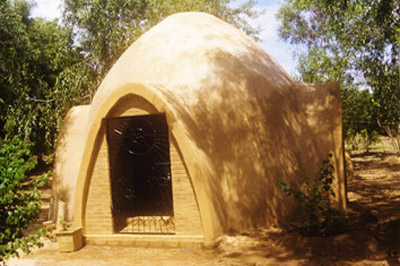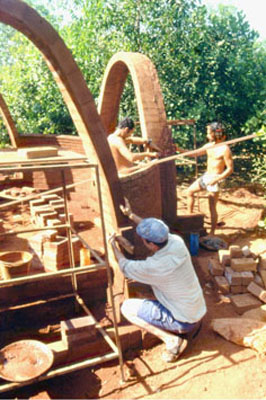Vaulted Structures
The research in Auroville with this kind of roofing aims to revive and integrate in the 21st century the techniques used in past centuries and millennia, such as those developed in ancient Egypt or during the period of Gothic architecture in Europe.
This R&D seeks to increase the span of the roof, decrease its thickness, and create new shapes. Note that all vaults and domes are built with compressed stabilised earth blocks which are laid in “Free spanning” mode, meaning without formwork. This was previously called the Nubian technique, from Egypt, but the Auroville Earth Institute developed it and found new ways to build arches and vaults.
The traditional Nubian technique needed a back wall to stick the blocks onto. The vault was built arch after arch and therefore the courses were laid vertically. The binder, about 1 cm thick, was the silty-clayey soil from the Nile and the blocks used were adobe. The even regularity of compressed stabilised earth block produced by the Auram press 3000 allows building with a cement-stabilised earth glue of 1-2 mm only in thickness.
The free spanning technique allows courses to be laid horizontally, which presents certain advantages compared to the Nubian technique which has vertical courses. Depending on the shape of vaults, the structures are built either with horizontal courses, vertical ones or a combination of both. All vault shapes are calculated to develop catenary forces in the masonry. Their thickness and span can therefore be optimised.
This R&D seeks to increase the span of the roof, decrease its thickness, and create new shapes. Note that all vaults and domes are built with compressed stabilised earth blocks which are laid in “Free spanning” mode, meaning without formwork. This was previously called the Nubian technique, from Egypt, but the Auroville Earth Institute developed it and found new ways to build arches and vaults.
The traditional Nubian technique needed a back wall to stick the blocks onto. The vault was built arch after arch and therefore the courses were laid vertically. The binder, about 1 cm thick, was the silty-clayey soil from the Nile and the blocks used were adobe. The even regularity of compressed stabilised earth block produced by the Auram press 3000 allows building with a cement-stabilised earth glue of 1-2 mm only in thickness.
The free spanning technique allows courses to be laid horizontally, which presents certain advantages compared to the Nubian technique which has vertical courses. Depending on the shape of vaults, the structures are built either with horizontal courses, vertical ones or a combination of both. All vault shapes are calculated to develop catenary forces in the masonry. Their thickness and span can therefore be optimised.




























Contact US
- Address:Auroville Earth Institute, Auroshilpam, Auroville 605 101 - T.N. India
- Phone:+91 (0) 413 - 262 3330 / 262 3064
- Email:info@earth-auroville.comOpens in your application

